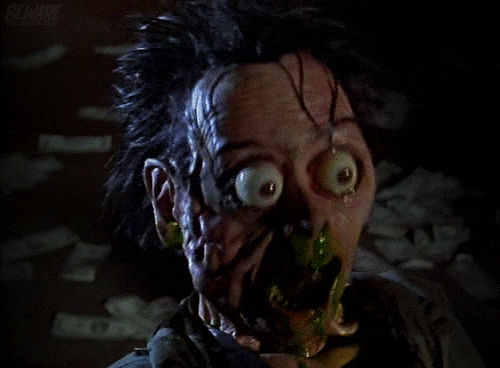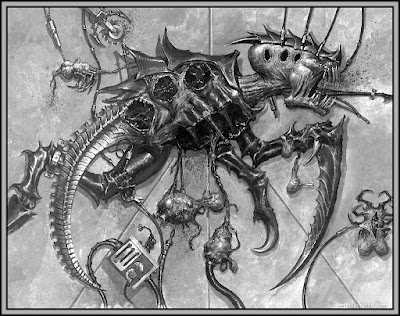Humanity's fascination with vampires and bloodsucking monsters is probably as ancient as our earliest cultures and yet in most cases, at least in modern times, the word vampire is associated with bats, wolves and even leeches but so rarely does it ever connect to the group of organisms that ironically seem to specialise in blood feeding a lot more commonly than any vertebrate.
It would be silly to argue against the fact that parasitism is one of the most successful lifestyles on the planet. Parasites make up more than half of the complex organisms on Earth and range from animals, to plants and fungi all the way down to single celled life and if we really want to stretch it even viruses.
Yet most parasites are endoparasitic, meaning they inhabit the internal space of the host in contrast to ectoparasites who prefer to latch onto the surface area or within furs, hair, folds, wrinkles or any other irregularities on the integument of the host.
It's easy to assume that most arthropod parasites are ectoparasites, animals such as ticks, fleas and lice have become iconic poster faces for parasitic pests and infestations, however there are many endoparasites as well especially among insects. In fact if parasitoid wasps truly match the current estimated number of undiscovered extant species which varies anywhere between a million to 2-4 million (depending on who you ask) then the vast majority of animal parasites on the planet are indeed endoparasitic! And this is ignoring the myriad of dipteran parasitoids, strepsipterans and potentially even beetle species that also prefer to dig inside their hosts.
Still mankind has been intimately familiar with bloodsucking insects and other arthropods for millennia but rarely have we used them as part of the vampiric myths. Of course moths, flies and spiders have been associated with vampires as far back as the medieval ages but not particularly due to their feeding habits (although funny enough there are vampire moths alive today).
Sadly this trend carries over into fiction and the whole representation of non-mammalian themed vampires is rather low. Luckily the few example that do exist tend to be as wacky as possible to compensate for a genre dominated by bats and wolves.
Even with a limited selection I'm still certain I can't cover even half of the available insectile vampires in fiction, nor do I believe I should. What I want to do is provide you with some examples I'm personally aware of, the rest is up to you!
No better place to start this blood bug hunt than the little indie hit that recently rejuvenated the interest in more unconventional vampires, at least in gaming.
No matter how you feel about indie games it's undeniable they are currently the only source of experimentation in the gaming industry, often quite limited due to budget or time restraints but still a newly established source of fresh ideas and concepts.
Darkest Dungeon is no exception, it is a game oozing with atmosphere and sheer creativity.
This is best reflected in the enemy roster.
From ticks and fleas to vermiform larvae and mosquitoes, the vampires of Darkest Dungeon are almost as diverse as the bloodsucking groups they represent.
All culminating in a vampire queen design I can only call... Superbly twisted yet still elegant and hauntingly feminine without sacrificing even an ounce of the menacing aura crucial to any royal insectile monster!
While Darkest Dungeon is an excellent example of modern indie excellence we can still go a bit further back in gaming history to find another classic fantasy gem with a larger focus on vampirism.
1999 saw the release of one of the most beloved vampire games of the generation, Legacy of Kain: Soul Reaver.
A game known for its intricate lore, unmatched worldbuilding and most importantly redefining what a vampire is.
Without spoiling too much the game is set in a post-apocalyptic dark fantasy world overrun by several types of vampires all descended from high ranking vampire lieutenants. Each clan is fundamentally different and unique not only in appearance but also behaviour and philosophy.
One such leader is Zephon!
Once a human turned vampire commander he is later slowly mutated, twisted and metamorphosed into an insectile monstrosity of equally horrifying size and strength.
And yes, he does seem to be a homage to the Xenomorph Queen from Aliens, it's a trend we'll keep seeing a lot on this blog when analysing insectoid royalties in fiction.
His offspring are, like all the other minion types, rather animalistic and simple creatures which of course doesn't make them any less dangerous to face and deal with.
Soul Reaver has every reason to be considered a cult classic game among not just gamers but vampire and monster fans as well. While the gameplay and arguably graphics have aged quite poorly the originality and creativity emanating from the creature designs is absolutely admirable to this day!
So far we've looked at two games separated apart by more than a decade and have seen how wild and bizarre a truly monstrous vampire can be, especially when infused with arthropodal traits.
What about cinema then? Surely there's a wide selection of creepy crawly bloodsuckers?
While the answer would generally be positive the inherit limits of the movie medium especially live action condemns most vampire designs to the already known and easy to implement humanoid frame.
That is not to say any artistic liberties with the overall concepts and designs are out of reach.
One of the earlier examples of weirdly insectile vampires in cinema is surprisingly not even technically a vampire movie, or a zombie movie, or even directly connected to insects or any arthropods. The themes and original title however reveal the true origin of the story's concept.
Ah yes Cronenberg, who else can take what appears on surface level as your standard Night of The Living Dead scenario and spin into... this.
The movie's initial title was Mosquitoes before being changed to a more generic and I guess straightforward one.
So what does this zombie/vampire flick of old have to do with insects or bloodsucking parasites?
I'd say go watch it, preferably with a partner or family.
Lets move on, shall we?
I feel bound by monster movie rules of etiquette to mention Guillermo del Toro every time I'm discussing weirdly gruesome monsters.
Little known fact about del Toro is that he himself has claimed to be an amateur entomologist in previous interviews, which should come to no surprise to his fans considering his obvious fascination with the insect world.
Mimic is a movie I hold in high regard, it's a stylish sleek tale of man vs insect presented in a way only del Toro can deliver.
Yet there is a lesser known "bug movie" he made a bit later and by lesser known I mean one of the most successful comic book movie adaptations of the time. Unfortunately the lesser part refers to the fact few if any associate it with insects.
Blade 2 is an interesting movie, both as an adaptation to a beloved comic book series and hero as well as a slight departure from its predecessor both thematically and in regards to closely following the source material.
Once again employing more outlandish vampire designs requires redefining and restructuring of what makes a vampire what it is.
The movie introduces us to a new type of vampires, Reapers as they're called are hypervampires. And while yes they're stronger and more vicious than the typical ones we're all familiar with the hyper part refers to a real life term I'm quite fond of, hyperparasitism.
Most parasites are pretty content with inhabiting their host, still some go a step further and parasitise the parasite! They are called hyperparasites, or parasites of parasites. Now how deep the parasite hole goes is something I suggest you read about yourselves, for the purpose of this analogy I feel like Blade 2's Reapers fit the term perfectly. They are vampires that feed on other vampires thus making them hypervampires!
Just by looking at their choice of prey and hunting practices we are starting to sense the insect inside them.
If you look at the complex mouth parts, presence of what I could call a proboscis feeding tentacle, short but energetic lifespan, a pseudo-hive mentality and absolutely relentless animalistic aggression with zero regard for one's own safety... yes I consider them insectile by any definition of the word.
Guillermo del Toro has the gift of looking at nature and extracting exactly what he needs to mess with his audience's fears and dread while also maintaining a certain almost fairy tale feel and quality to his macabre creations. The Reapers in Blade 2 are no different.
Of course he would later go on to expand on the concept even more in The Strain franchise but I don't think there's much I could add from it here that would make a significant contribution to the analysis.
And now we have two movies and two games all excellent examples of how vampires can be insectile and not only still be recognisable as such but also enhanced by the addition of more diverse physical and behavioural traits.
I was struggling even before starting to write this post on whether I should mention this last example here or devote an entirely separate analysis for it down the line. Considering how unreliable life is these days I decided to include it here as a great way to end this brief look at creepy bloodsuckers.
What can possibly be better than a monstrous insect themed bloodsucking creature of the night?
How about a vampiric werebeetle?
This is Stun, Stun is an insect, he was also a man once.
Stun The Insect is one of many incredibly well designed fighters from the Bloody Roar game franchise.
He was a scientists caught in the middle of a conspiracy and thrown into a world of zoanthropes, humans who can transform into a more beastial form depending on what animal is locked inside them.
Stun however is quite different, cursed if you will.
He is a man-made monster, genetically fused with insect DNA against his and nature's will.
The result was the first human insect zoanthrope in history, with the unfortunate side effect of giving Stun a perpetually decaying body... unless he periodically consumes human blood.
In his very own mind Stun is now a vampire, as well as a mutant and a werebeetle.
I can't help but be excited by such a unique take on both vampirism and lycanthropy with a typical for early Japanese entertainment insect spin!
I might find a way to expand my analysis of the character into a full post some day but for now I highly recommend you check the Bloody Roar games yourselves.
And with this last example of a chitinous vampire I hope I managed to convince at least some of you that a vampire is not really confined by its mythological or folklore roots but rather as with any monster that enters into fiction and pop culture it needs to constantly evolve, adapt and respond to the ever changing world we live in and much like in real life insects tend to master those abilities to perfection.
The question of whether vampires can exist is an easy one to answer, especially during a nice warm afternoon in the open or a good deep slumber tucked in an old bed. The next morning's itch will serve as your personal answer.
Stay Bugged!


















.jpg)




Comments
Post a Comment